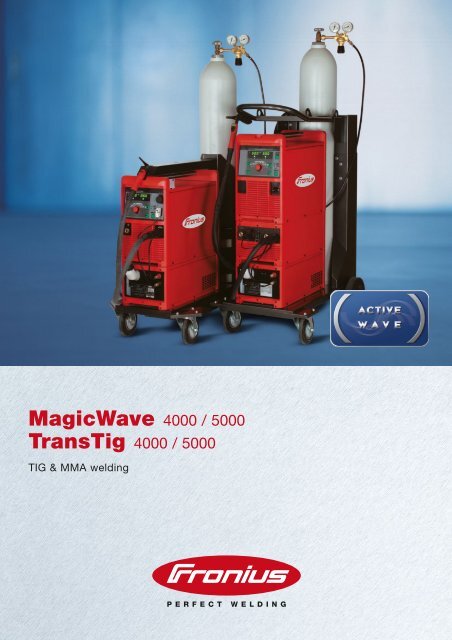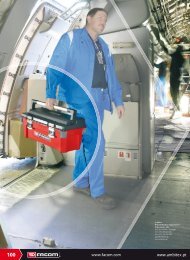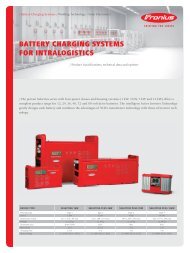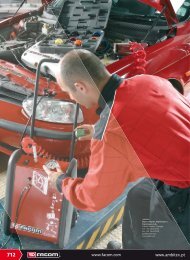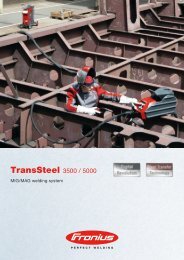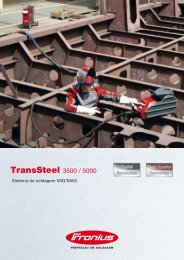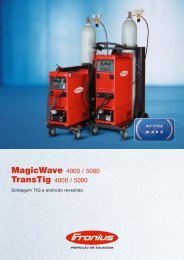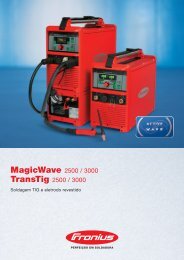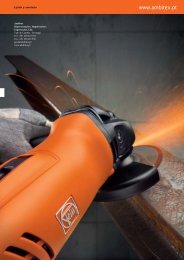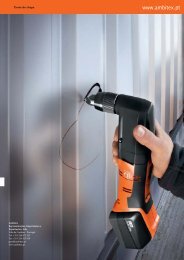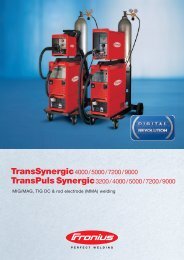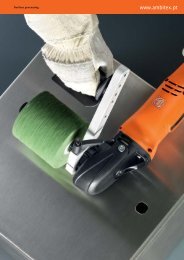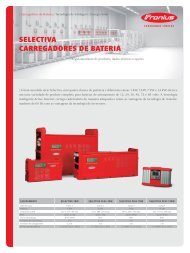MagicWave 4000 / 5000 TransTig 4000 / 5000 - Ambitex
MagicWave 4000 / 5000 TransTig 4000 / 5000 - Ambitex
MagicWave 4000 / 5000 TransTig 4000 / 5000 - Ambitex
- No tags were found...
Create successful ePaper yourself
Turn your PDF publications into a flip-book with our unique Google optimized e-Paper software.
<strong>MagicWave</strong> <strong>4000</strong> / <strong>5000</strong><strong>TransTig</strong> <strong>4000</strong> / <strong>5000</strong>TIG & MMA welding
A threefold technological triumphGENERAL REMARKSUTILISATIONQuiet, tough, stableTIG welders can raise a heartfelt cheer! Specially forthem, Fronius has developed a series of machines thatmake their every wish come true: <strong>MagicWave</strong> <strong>4000</strong>/<strong>5000</strong>for DC and AC, and <strong>TransTig</strong> <strong>4000</strong>/<strong>5000</strong> for DC. ActiveWave and digitisation are the key technologies underlyingthis machine concept.These power sources are up-to-the-minute charactersthat are a pleasure to work with, in every way: Ever-sodiscreet, with a super-quiet yet highly stable arc. Extremelystraightforward to use – in fact, almost self-explanatory.Tough, powerful and completely digitised – unlike anyother TIG machine, by the way.What is more, every single one of these machines belongsto a complete, totally co-ordinated welding system, eachof whose components perfectly complements all theothers. All in all, the upshot is the sort of welding resultswhich up to now you could only dream of.Outdoor enthusiastsOne of the many things that make the new <strong>MagicWave</strong>and <strong>TransTig</strong> machines such a pleasure to work with isthe fact that they are designed for both field andproduction use. They can put up with the toughestconditions imaginable, performing superbly all the time.In terms of materials, these welding systems are verysuitable for aluminium and its alloys, but also for low andhigh-alloy steels and non-ferrous metals, of course.Thanks to their great versatility, the <strong>MagicWave</strong> <strong>4000</strong>/<strong>5000</strong>and <strong>TransTig</strong> <strong>4000</strong>/<strong>5000</strong> are used right across the entirespectrum of industry - from the construction of chemicalplant, tanks and containers to mechanical and plant engineering,pipeline construction, automotive and railwayengineering and aerospace, and taking in all site-erection,maintenance and repair firms. Delivering just as perfectresults when used for robot welding as in manual welding.
ECONOMYFACTSA pleasing side-effectThis series of TIG machines is a fine example of just howefficient modern welding systems can be. Their efficiencybegins with the high-grade componentry that is used forall Fronius machines. Special mention should also bemade of their high degree of power efficiency, extremelylow open-circuit power, automatic cooling-unit cut-out(which has a direct and measurable impact on the currentconsumption), and of course the automatic capshapingfunction, which reduces the working timesneeded by the welder. All in all, these features result inoutstandingly long operational life, a small number ofwearing parts, and lower labour costs. And thus in awelding system that is highly cost-effective in every way.Active Wave technology boosts profitability:– Whole system is totally digitised: Power source, weldingtorches, remote-control units, robot interfaces, PC tools.– Digital signal processor (DSP) regulates and controls thewelding process.– Available in both “Standard” and “Job” versions. “Job” offersextra functions such as job-mode, and supports cold-wirecontrol and automated applications.– Exceedingly high arc stability, even on aluminium base metalsfrom which the oxide has been completely removed; noinstability (verifiably so)!– Special program for aluminium: Automatic shaping of the capon the pointed electrode tip, for perfect root fusion.– TAC function for faster tacking of materials.– Series feature: If welding is performed with two powersources, both arcs are synchronised to permit simultaneouswelding on both sides.UTILISATIONMaterials– Aluminium and its alloys– Non-ferrous metals– Low and high-alloy steelsApplications– Manual welding– Robot weldingIndustrial sectors– Construction of chemical plant, tanks and vessels, machineryand plant– Automotive engineering and construction of railway rollingstock– Aerospace– Site-erection contractors, maintenance and repair firms– Pipeline construction– Shipbuilding
Welding made easyWELDING PROPERTIESSimply perfectThe new Fronius welding systems have been thought outright down to the last detail. For every possible application,the goal was nothing less than perfection itself. Theresult is a system that makes every single operating stepas easy and pleasant as possible. From ignition all theway through to the end of the weld, from tack-welding toshaping the electrode cap. But let's take one thing at atime.We'll start with the ignition, which plays a key rôle in TIGwelding. On each of the machines, ignition is possibleeither with or without touchdown. In non-contact ignition,the arc starts immediately with a high-voltage impulse,ensuring perfect ignition right from the first push of thebutton - even when using extra-long hosepacks. Touchdownignition is especially valuable in sensitive areas ofapplication. And the important thing here is to make surethat there are no tungsten inclusions. The digital processcontrol takes good care of this, perfectly controlling theentire sequence.TAC: Spot-by-spot tack weldingBefore you can weld, you have to tack. The usual way ofdoing this is to merge the two weld-pools by making aslight movement with the torch. With TAC, one spot is allit takes. And so on. And the one after that. And so on.Because with TAC, the arc during tacking is not continuous,but pulsed. And this prompts the two weld-pools to“jump together”, in next to no time, to make one singleweld-pool. This works fast, and is a lot easier than theold method. The TAC function is also very useful whenlight-gauge sheets are being welded without filler metal,as it helps the weld-pools to merge more thoroughly.Active Wave ensures peace and quietFrom now on, TIG AC welding will be a much quieterbusiness - with a much quieter arc. All thanks to ActiveWave: The integrated digital signal processor alwayscomputes - in real time - the waveform that will permitthe highest possible arc stability with the lowest possiblenoise-emission levels. Measurement of these noise levelsclearly shows that with Active Wave, even when themachine is delivering 300 A of power, the dbA value isstill below 80 dbA. If you're not a welder yourself, andwant to know how important this development is, thenjust ask one!dbA9080706060 120 180 240 300 AFor sensitive areas of application: Touchdown ignitionNoise volume from conventional invertersReduced noise volume from Active Wave
All's well that ends wellA perfect start needs to be followed by a perfect finish.At the end of the weld, there are two main things towatch out for: The first of these is the gas post-flow, tomake sure that the electrode and the weld-pool do notoxidise. In the past, the gas post-flow had to be set manually.On the digital machines, the ideal post-flow timeis computed automatically. The second thing is the endcrater. This has to be filled, at a lower amperage. Thenew power sources take care of this, too, with the craterfilland downslope function.Simultaneous welding on both sidesWhen joining plates, you normally have to weld a rootpass first. This then has to be ground and back-welded –a time-consuming procedure which you can speed up bywelding from both sides simultaneously. In “both-sidessimultaneously”TIG-AC welding, both arcs have to besynchronised. And to help you do this, the <strong>MagicWave</strong>power sources have a “SyncMode” function which harmonisesboth the arcs.Special program for aluminiumAluminium always needs special treatment. So Froniushave made sure that it gets it. For example, in TIG ACwelding, aluminium is normally not welded with a pointedelectrode tip, but with a shaped cap at the tip of theelectrode. On fillet welds, this leads to inadequate rootfusion. The <strong>MagicWave</strong> machines use a pointed electrodewith a much smaller shaped cap, and with perfect rootfusion as a result.The cap is shaped automatically, by the way, whichmeans huge time-savings. All you need to do is clampthe pointed electrode into the electrode holder and preselectthe cap diameter, and the arc then immediatelyforms the shape and size of cap that you want. Anotherinteresting function enables you to make variable adjustmentsto the AC waveform, giving the welder reliableweld-pool control even at high amperages.Cap diameter: 1 mmBase metal: AIMg3Sheet thickness: 5 mmWelding amperage: 185 AWelding voltage: 15.6 VAC Balance: -5Cap diameter: 3.2 mmBase metal: AIMg3Sheet thickness: 5 mmWelding amperage: 185 AWelding voltage: 15.6 VAC Balance: 0
The more complex they are,the easier it getsHANDLINGFlexible workplacesRemote control units are really practical. They come inespecially handy for welders, because they let youintervene in the welding process and change parametersdirectly at the scene of the action. No matter where yourwelding machine happens to be. Special mention shouldbe made here of the JobMaster TIG welding torch, whichcomes with integral remote control. This lets you call upall your settings, any time and anywhere, regardless ofwhere the machine is standing. The JobMaster TIGwelding torch features a digital parameter display, jobrecall and freely selectable parameters, meaning that youdecide for yourself which parameters you want to alterduring welding.A few more words on the torch: Particularly advantageouslyfor TIG welding, this comes with a leather hose,whose much greater flexibility means that the welder onlyhas a smaller proportion of the total weight of the torchto carry with him while he works. The torch also has anergonomically shaped handle and a swivel-mountedhosepack. Another great feature is the torch centralconnector F++, with a separate water connector so thatthere is absolutely no way that any coolant can get intothe gas channel and cause porosity in the weld metal.Different types of job call for different types of weldingtorch. Which is why there is a special one for robot applications,with an integrated cold-wire feeder unit. Or aspecial cold-wire torch for manual welding with anintegrated wirefeed – used mainly for series applicationswith good accessibility. By the way, the cold-wire controlsystem, complete with all parameters, is already integratedin the power source.JobMaster TIG welding torch with integrated remote-controland display<strong>MagicWave</strong> <strong>5000</strong> and Robacta TTW 4500 robot welding torch withRobacta KD-Drive cold-wire feeder unit
For cold-wire applications: TTW <strong>4000</strong> KD welding torch with integratedremote-control, display and wirefeed unitTR 2200 F remote-control pedal unit: For precision control of thewelding amperage at all timesSAFETYA complete system, from the robot interfaceall the way through to the TIG welding torchFronius is a system supplier. Each member of the systemis designed to “fit in” optimally with all the others, inperfect harmony. It takes in everything from modularlydesigned power sources (available for both gas andwater-cooled torches, incidentally), to remote-controlunits, cooling units, trolleys and a wide range of differentrobot interfaces, as well as complete welding-datadocumentation and visualisation.Quality at the push of a buttonEven welding systems with very wide-ranging functionalityought to be easy to operate. And it is just this which isyet another big strength of the Fronius systems. Theextensive know-how stored in the systems can be intuitivelyretrieved, and the control panels are self-explanatoryand straightforward. What is more, there is a choice oftwo different control panels for this series of machines:Standard or Job. The “Job” control panel offers additionalfunctions such as job mode, and enables cold-wirecontrol and automated applications.Green lights all roundAs anybody at all familiar with Fronius machines will know,their safety features are second to none. Every powersource comes with the CE mark and with the S mark -permitting welding in confined spaces in conditions ofenhanced electrical hazard, also when AC welding, ofcourse. What is more, each of the power sources amplyfulfils the requirements of IEC “degree of protection IP 23”,meaning that it is safely protected from dirt and water, foruse in the field. The integral fan is thermostat-controlledand so only runs when it is needed. This reduces dirtcollection and prolongs the service life of the powersource. At Fronius, though, safety starts even sooner: inthe development stage. The <strong>MagicWave</strong> and <strong>TransTig</strong>machines were designed from the ground up to be sorobust and compact that they can take just about anythingin their stride.<strong>TransTig</strong> control panelDisplay field<strong>MagicWave</strong> “Job” control panelDisplay fieldFunctionalsequenceOperating modeFunctionalsequenceOperating modeProcessAdjusting dialMemory buttonAdjusting dial
TECHNICAL DATAMW <strong>4000</strong> MW <strong>5000</strong>Power source TT <strong>4000</strong> TT <strong>5000</strong>Mains voltage 3 x 400 V 3 x 400 VMains voltage tolerance ± 15 % ± 15 %Mains fuse protection (slow-blow) 35 A 35 APrimary continuous current (100 % d.c.) 15.5 kVA 1 17.9 kVA 2Cos phi 0.99 0.99Welding current range TIG 3 - 400 A 3 - 500 AMMA 10 - 400 A 10 - 500 AWelding current at:10 min/40 °C (104 °F) 40 % d.c. – 500 A10 min/40 °C (104 °F) 45 % d.c. 400 A –10 min/40 °C (104 °F) 60 % d.c. 365 A 440 A 710 min/40 °C (104 °F) 100 % d.c. 310 A 350 AOpen-circuit voltage 86 V 86 VWorking voltage TIG 10.1 - 26.0 V 10.1 - 30.0 VMMA 20.4 - 36.0 V 20.4 - 40.0 VIgnition voltage (Up)* 9.5 kV 9.5 kVDegree of protection IP 23 IP 23Type of cooling AF AFInsulation class F FDimensions LxWxH (with handle) mm 625x290x705 3 625x290x705 3Inches 24.6x11.4x27.8 4 24.6x11.4x27.8 4Gewicht 58.2 kg 5 58.2 kg 5128 lb 6 128 lb 6*The arc ignition feature is suitable for manual operation.1On the TT <strong>4000</strong>: 11.8 kVA 5On the TT <strong>4000</strong>/<strong>5000</strong>: 39.8 kg2On the TT <strong>5000</strong>: 15.1 kVA 6On the TT <strong>4000</strong>/<strong>5000</strong>: 87.7 lb3On the TT <strong>4000</strong>/<strong>5000</strong>: 625x290x475 mm 7 On the TT <strong>5000</strong>: 450 A4On the TT <strong>4000</strong>/<strong>5000</strong>: 24.6x11.4x18.7 inWelding torch TTW <strong>4000</strong> A TTW <strong>5000</strong> AWelding current: AC 350 A 400 ADC 400 A 500 ADuty cycle 60 % 60 %Electrode diameters 1.0 - 4.0 mm 1.6 - 6.4 mmWeight 0.96 kg / 2.1 lb 0.985 kg / 2.2 lbCooling unitFK <strong>4000</strong> RCooling capacity at Q = 1 l/min. +40 °C / 1000 WMax. delivery rate3.5 l/minCoolant volume5.5 lDegree of protection IP 23Dimensions LxWxH mm 700 x 280 x 250Inches 27.6 x 11.0 x 9.8Weight (without coolant)16.3 kg / 35.9 lbCHECKLISTDigital weld-process controlMicroprocessor controlEnergy-saving inverter technologyGenerator-compatibleThermostat-controlled fan / overtemperature protectionEarth leakage monitoringContinuous welding-current adjustment from torchRemote-controllableSwitchover facility between touchdown and HF ignitionAutomatic gas post-flow (dep. on welding current)Gas-test functionAutomatic cooling-unit cut-outAnti-stick functionFreely selectable parameters on the welding torchJob modeAutomatic cap-shaping functionPolarity reversalRPI ignitionKeylock switchRate-of-flow watchdog for torch cooling systemExternal current-flow signalRobot interface, analogue/digitalCold-wire controlOperating modes2-step mode / 4-step modeTAC (programmed tack-welding)AC / DCSpecial 4-step modeTIG-PulsSpot weldingDigital indication ofRun-statusOperating modeWelding voltage, welding amperage (actual value)“Hold” functionOvertemperatureService codeMains voltage monitoringJob numberAdjustable parametersWelding power (continuously adjustable)Electrode diametersGas pre-flow time / gas post-flow timeCrater-fill current / start-arcUpSlope / DownSlopeHot-Start / arc-force dynamicAC balance / AC frequency / AC waveform• as standard o optionalMWMW JobTTTT Job••••••••••••••••••••••••••••••••••••••••••••••••••••• •• •••••••o o o oo o o oo o o oo oo o••••••••••• •• •• •••••••••••••••••••••••••••••• •••••••••••••••••••••••••••Text and illustrations technically correct at time of going to print. We reserve the right to make modifications.This document may not be copied or otherwise reproduced, whether in part or in its entirety, without the express prior written consent of Fronius International GmbH.FRONIUS INTERNATIONAL GMBHBuxbaumstrasse 2, P.O.Box 264, A 4602 WelsTel: +43 7242 241-0, Fax: +43 7242 241-3940E-Mail: sales@fronius.comwww.fronius.com<strong>Ambitex</strong>Representações, Importações eExportações, Lda.Vale de Cambra - PortugalTelefone +351 256 472 352Fax +351 256 425 938geral@ambitex.ptwww.ambitex.pt40,0006,2451 (1/05)


